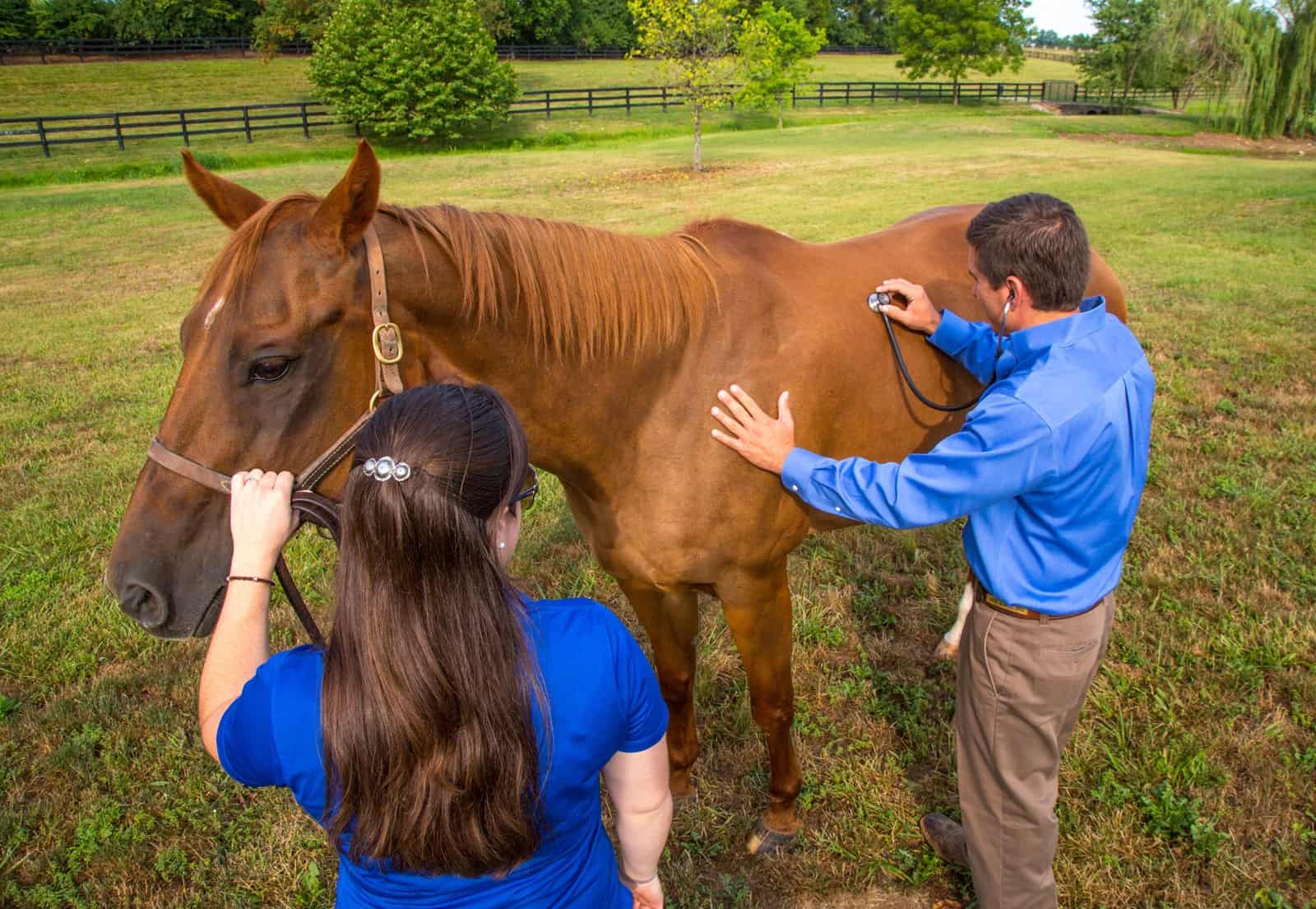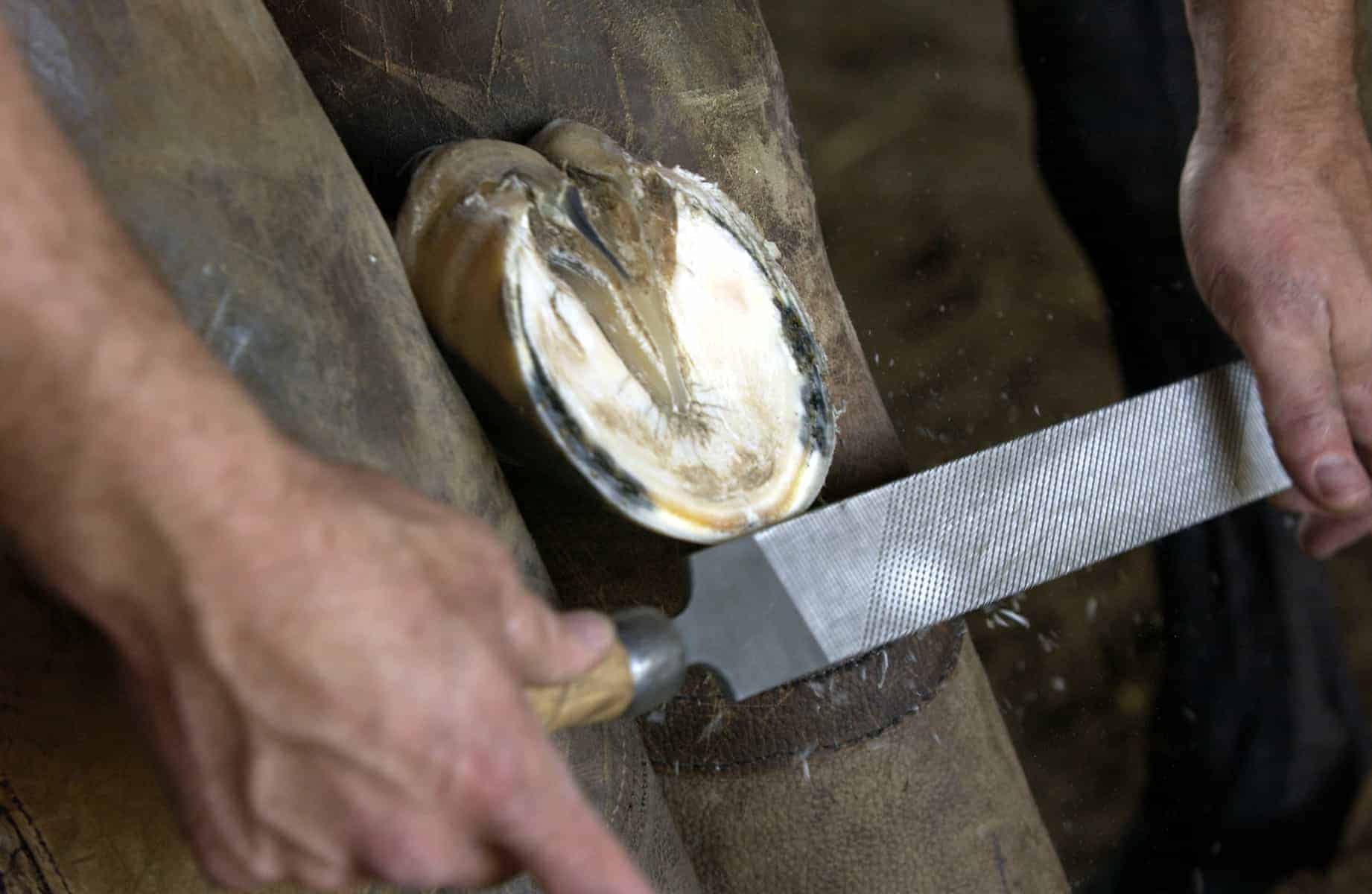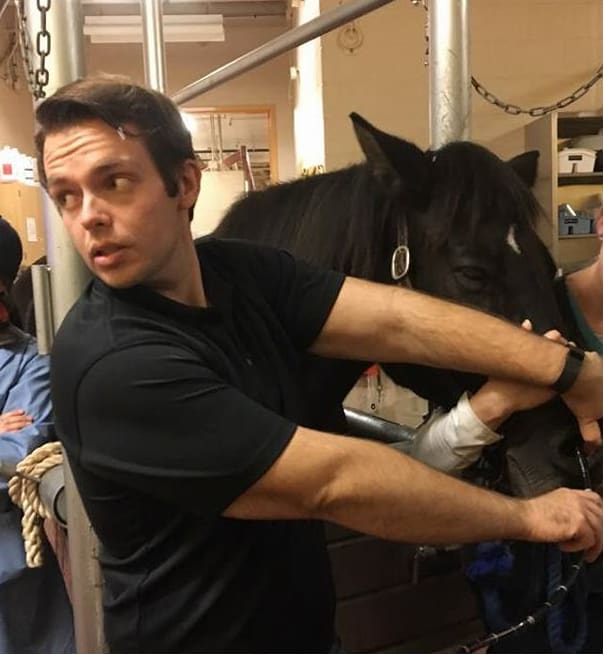Equine Wellness Exams 101

Is your horse’s annual wellness exam and preventative care comprehensive and complete?
Decades ago, equine wellness was simple and archaic. Horses were turned out in a paddock, given free-choice forage (and maybe grain), and lived there whenever not working. Cut to today: Equine wellness involves far more—and we don’t mean yoga or organic fruit smoothies. Wellness serves as the umbrella term that covers all aspects of equine care and welfare. Owners need to be aware of nutrition, hoof health, preventive medicine, and much more.
Many equine veterinarians offer wellness packages to help their clients juggle the many items on their equine health checklist. While packages differ from clinic to clinic, the overall message is one: to provide owners the resources and information with which to optimize their horses’ health and well-being. These annual or semiannual visits often include vaccinations, dental exams, tests such as bloodwork and fecal egg counts, and nutrition consults. In this article we will describe common wellness steps, as well as how your veterinarian can help you address and correct problems you might encounter.
The Physical Exam
Your veterinarian undertook many years of study to learn to perform a thorough physical exam and uses this tool daily to evaluate all of your horse’s body systems. He or she will assess your horse’s vital signs, auscultate (listen with a stethoscope) the lung fields, listen to your horse’s gut sounds, take your horse’s digital pulses, check his gum color and capillary refill time, look at the eyes, inspect the legs and feet, determine body condition score, and more.
What are Vital Signs?
Vital signs are parameters to quickly assess your horse’s overall condition in that moment. Generally, they include heart rate, respiratory rate, and temperature. Learn to measure these by visiting TheHorse.com/normal-vital-signs or asking your veterinarian for a “vitals lesson.”
The information your veterinarian gathers can help him or her move forward in assessing your horse’s condition. Is he slow to shed out this year? Consider testing for endocrine disorders. Is he dropping feed? Maybe a dental exam is in order. Has he been footsore? It might be time to take radiographs (X rays) to assess his coffin bone configuration.
Senior horse considerations The tests your veterinarian will recommend during a wellness visit depend on the horse’s age. Bloodwork, while beneficial for all ages, is especially helpful for checking a senior’s systems. Baseline bloodwork allows vets to evaluate major organ function and make sure all systems are a go.
During the exam your veterinarian will also look for early signs of endocrine disorders such as pituitary pars intermedia dysfunction (PPID) and equine metabolic syndrome (EMS), to which seniors are prone. The first is a condition of the horse’s pituitary gland, located at the base of the brain. An affected horse’s pituitary gland produces hormones that stimulate the adrenal gland to produce excessive levels of cortisol (the stress hormone), leading to an array of problems: decreased shedding, increased drinking and urine output, decreased wound healing, laminitis, and more. Annually your veterinarian will take a blood sample to measure your horse’s adrenocorticotropic hormone (ACTH, the overproduced hormone in PPID horses) values in response to thyrotropin-releasing hormone (TRH) administration. Thankfully, a drug, pergolide, is available that has been proven to lower affected horses’ cortisol.
Horses with EMS are usually easy keepers that seemingly get fat on air. While not exclusively an old-age disease, EMS can be diagnosed in geriatric equids. Practitioners use annual bloodwork to test for insulin resistance, a condition that results in increased insulin circulating in the blood and associated problems, the most common of which is laminitis.

Vaccinations
Each spring your horse’s veterinarian will visit the farm to perform routine health tasks such as pulling blood for a Coggins test to rule out equine infectious anemia and administering vaccinations.
“Vaccines are designed to (induce) a horse’s natural immune response to common infectious organisms and induce long-term (immune system) memory,” says Laura Perry, DVM, of West Wind Veterinary Hospital, in Sherwood Park, Alberta.
A vaccine exposes a horse to a nonpathogenic (not disease-causing) particle of a particular disease. This substance will not infect your horse but, rather, allow him to mount an immune reaction to it. This way, if vaccinated horses get exposed to the disease agent, “their immune systems can rapidly recognize the pathogen and launch a response to combat the infection,” Perry says.
Does every horse need every available vaccine? Absolutely not. Instead, there are core and risk-based vaccines. “Core vaccines (Eastern/Western equine encephalomyelitis, rabies, tetanus, West Nile virus) protect against diseases that are endemic, are highly contagious, pose a significant risk for disease, are of a public health significance, or (for which the vaccines) are required by law,” Perry explains.
Veterinarians recommend these core vaccines for every horse, regardless of lifestyle. Risk-based vaccines (e.g., strangles, influenza, equine herpesvirus, etc.) guard against diseases that are not necessarily widespread. Whether a horse should receive these immunizations depends on his lifestyle, diet, where he lives, and other factors that put him at risk for encountering the pathogens in question.
Senior horse considerations Contrary to popular belief, there are no published data suggesting senior horses have lifelong immunity to diseases because they were vaccinated regularly. In fact, recent research has revealed senior horses have reduced immunity. Geriatric horses still very much require at least the core vaccinations to be protected.
For a complete list of core vs. risk-based vaccines, see our vaccination cheat sheet.

Hoof Care
Though veterinarians are not responsible for day-to-day hoof maintenance, it is still an essential part of equine wellness. After examining your horse’s hooves, your veterinarian can offer guidance on conditions affecting them (e.g., thrush, subsolar abscesses, white line disease) and provide recommendations for farrier care. This might be augmented by diagnostic imaging.
Finding a competent, reliable, trustworthy farrier is an absolute necessity. These professionals are on the front line of hoof care and see your horse more frequently than your veterinarian does. The hoof grows continuously and needs to be addressed on a regular schedule. Ignoring this growth can lead to severe conditions that can affect your horse’s comfort.
“You’ll see mechanical changes that compromise the hoof and the leg or soft tissue changes of the limb, both of which can lead to lameness,” says Patrick Reilly, chief of farrier services at the University of Pennsylvania’s New Bolton Center School of Veterinary Medicine, in Kennett Square.
Commonly, farriers assess horses every six to eight weeks. Prolonging this interval can lead to devastating hoof changes. “We know the hoof angle gets 3.5 degrees lower over the course of seven weeks,” says Reilly. “We know there is 11.5% increase of force on the deep digital flexor tendon (that runs down the back of the lower limb and attaches to the bottom of the coffin bone within the hoof) at an eight-week cycle.”
Roughly 80% of lameness cases start in the lower limb. Hoof care neglect can contribute, causing obvious discomfort and lameness. “It’s almost always beneficial to shorten the shoeing/trimming cycle,” Reilly adds. “The longer we go, the more detrimental effect it can be.
“Some sort of collaboration between the vet and the farrier is best,” he says.
Whether your horse is a pasture pet or an elite performance horse, the veterinarian-farrier team is one of the most important factors in his success.
Senior horse considerations Laminitis is a common hoof syndrome of elderly horses. The inflammation of the laminae, which connect the inner hoof wall to the coffin bone and vice versa, is incredibly painful and can result in crippling lameness. If severe or left untreated, the laminae can detach and the coffin bone can rotate or sink, which can require euthanasia. While you can get a horse through a bout of laminitis, the disease doesn’t simply go away.
“If your horse has a history of any type of laminitis, part of a wellness exam is yearly radiographs,” says Reilly. “The whole nature of laminitis is the inside and outside of the hoof don’t match, and early detection of any problems is helpful.”
With the guidance and care of a good veterinarian and farrier, your horse can be trimmed and shod appropriately to live a comfortable and happy life.
Nutrition
When it comes to feeding horses, owners are increasingly adding a supplement for this, a top-dressing for that, and four types of concentrates. In nature horse diets aren’t usually that complex.
“I believe that forage is often overlooked as the most important component of a horse’s diet,” says Liz Routh, DVM, of Saginaw Valley Equine Clinic, in Michigan. “There are many horses that can fulfill all of their nutrient requirements by consuming pasture and/or high-quality hay alone (with water, of course).”
Hay testing can provide additional information about protein, vitamin, mineral, fat, and carbohydrate levels. “This is especially important in areas of the country that have known mineral deficiencies in the soil, such as selenium,” she says.
Some conditions do complicate horses’ dietary needs. Gastrointestinal or dental issues, for instance, can limit the amount of long-stemmed hay horses can consume. “A majority of these horses still benefit from having a reliable source of forage available in the form of chopped, cubed, or pelleted hay products,” says Routh. “However, some may require transitioning to a complete feed” intended to meet all the horse’s dietary needs, including forage.
Your veterinarian will assess your horse’s body condition during the wellness exam using the Henneke body condition scoring system to determine whether your horse is under- or overweight. This allows you to evaluate fat deposits at several sites and score them from 1 (emaciated) to 9 (morbidly obese).
Coming out of winter horses might be a bit thin at their spring wellness exam. Many times a horse is simply not getting enough feed, whether that be grain or forage. But the solution isn’t always as simple as increasing the volume.
“When I’m working with a horse owner to find the right nutritional plan for their horse, I make sure I take into account the age of the horse, the level of exercise or performance desired, body condition, and any concurrent diseases or endocrine disorders,” says Routh.
Foals and yearlings require different vitamin and mineral proportions for proper development, whereas adults require a more balanced diet. The horse’s use is yet another factor. “(A nutritional plan) will be drastically different between the racehorse, the weekend trail horse, and even the lactating mare,” says Routh. “Any horse with existing (endocrine) concerns will need a diet specially formulated to compensate for their individual needs and current body condition.”
Senior horse considerations Diets change as horses age. The efficiency of a horse’s gastrointestinal tract decreases, and geriatric animals are less able to absorb the nutrients and calories necessary to maintain their condition. Wellness exams are a perfect time to reassess senior diets, which can be literal lifesavers for these horses because they usually include a complete ration that will address all nutrient needs. Further, volume increases (made gradually) often help these horses, and adding another meal rather than increasing the amount fed at one time might help them stay in good condition.

Dentistry
Unlike the teeth of dogs, cats, and humans, a horse’s set of teeth constantly erupts from the gumline for decades. Therefore, horses need more regular dental care than companion animals.
Horses benefit from annual dental exams as part of their wellness assessment. Problems with teeth can manifest as a variety of signs, including weight loss, quidding (dropping food), reluctance to accept the bit, and choke. These exams are vital to assess for dental problems (e.g., sharp points, hooks, diastemas or gaps between teeth, tooth fractures, etc.) that affect the horse’s comfort and ability to eat. Some horses might have anatomic abnormalities such as dental waves or parrot mouth.
Regular dentistry can help keep problems at bay. Your veterinarian can perform a full sedated exam with a speculum to assess all aspects of your horse’s mouth. If needed, he or she can perform a dental float, removing any sharp and/or abnormal points and hooks. Successful floats allow the horse’s jaw to have complete range of motion while chewing and allow proper grinding of hay and grain.
Senior horse considerations A common misconception is that equine teeth erupt forever. On the contrary, a horse only has so much tooth to erupt, and tooth crown will eventually become very thin. Many geriatric horses, usually those around 30, lose teeth or wear them down to the extent they can no longer use them. Often, horses without a full set of teeth are unable to eat hay and rely on a diet of processed forage and soaked grain or complete feed.
Fecal Egg Counts
Our approach to parasitism in equine medicine has changed over the past few decades. Veterinarians no longer recommend the frequent use of anthelmintics (dewormers) to kill parasites before they can mature and lay eggs. That approach led to anthelmintic resistance: Essentially, deworming drugs today are no longer as effective, or in some cases effective at all, at addressing many types of parasites.
Veterinarians now have a tool, the fecal egg count (FEC), with which they can assess a horse’s worm burden—something they often do during wellness exams. The FEC guides the vet’s recommendations for testing frequency, anthelmintic choice, and timing of administration.
Take-Home Message
Horse care is a tedious and near-constant task. This is where the comprehensive wellness exam comes in. With your veterinarian’s help, you can provide your horse with regular and appropriate maintenance and catch signs of problems early to keep your herd happy, healthy, and comfortable.

Written by:
Chris White, DVM
Related Articles
Stay on top of the most recent Horse Health news with















